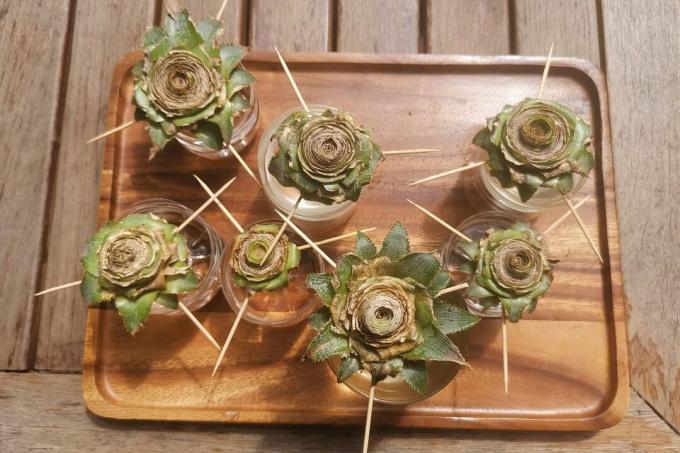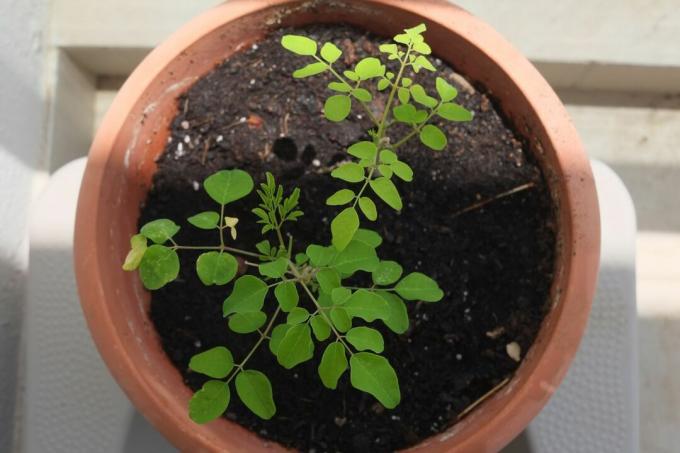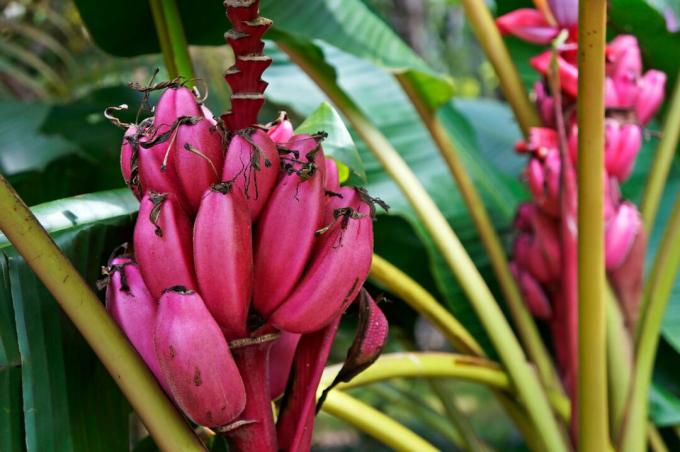Not only in the garden, but also in an apartment, useful plants can be grown and leaves, flowers and fruits can be harvested for the kitchen. We give an overview of edible houseplants.

There are many different types of houseplants, so there is sure to be a suitable plant for every house and apartment. Especially for households without a balcony or garden, edible houseplants offer the opportunity to grow food or spices yourself. But which houseplants are edible? We present various plants that are easy to keep indoors and whose leaves, flowers or fruits are edible.
contents
- Pineapple (Ananas comosus)
- Chili (Capsicum)
- True Aloe (Aloe vera)
- Ginger (Zingiber officinale)
- Prickly Pear (Opuntia ficus-indica)
- Cardamom (Elettaria cardamomum)
- Horseradish tree (Moringa oleifera)
- Vietnamese Coriander (Persicaria odorata)
- Room garlic (Tulbaghia violacea)
- Lemon Myrtle (Leptospermum)
- Citrus plants (Rutaceae)
- Dwarf Banana (Musa velutina)
Pineapple (Ananas comosus)
the pineapple is an edible houseplant and a particularly popular South Sea fruit. The bromeliad plant (Bromeliaceae) can easily be kept indoors all year round. The optimal location for pineapple plants is bright, warm and protected without drafts with a high relative humidity of around 60%. Even in winter, the temperature should not fall below 16 °C; 25 °C and more are ideal. Depending on the type and variety, the sprawling plants are between about 20 and 100 cm high. The long leaves are sharply serrated at the edge. With good care, the pineapple forms an inflorescence with numerous individual flowers, from which the delicious, compound fruit later develops. Incidentally, the pineapple can come through from the leafy stalk of the fruit regrowing be propagated. See our article on how to do this for detailed instructions Planting pineapples.

Chili (Capsicum)
Chilies are basically perennial plants, but in our latitudes they are often only cultivated once a year. However, the nightshade plant (Solanaceae) with its fiery, hot fruits can be cared for as a houseplant for several years. Depending on chilli variety the plants can grow to a height of between 10 and 120 cm and develop different colored fruits with different degrees of heat, measured in Scoville. The chili needs a location that is as warm, bright and sunny as possible. Otherwise, if there is a lack of light, it quickly sheds leaves. Cold drafts also damage the plant, which comes from South America. In order to achieve a good chilli harvest indoors as well, the open flowers must be shaken slightly every day so that they pollinate themselves. In nature, this is done by insects or the wind. Otherwise, it should be watered moderately and fertilized regularly to cover the high nutrient requirements. The successively formed fruits can then be harvested almost all year round.

True aloe (Aloe vera)
the aloe vera is probably one of the best-known edible houseplants. The easy-care succulent forms fleshy leaves with a slightly prickly leaf edge, inside which there is a transparent jelly. Real aloe is used in drinks, smoothies, salads or medicinal and natural cosmetics. The leaf bark is removed because it contains laxative substances. The gel-like inner leaf tissue soothes sunburn, skin injuries and insect bites. At the same time, the real aloe reproduces itself through genetically identical clones and thus ensures that there is always a supply. aloe vera prefers a sunny, warm location and can grow very strongly there. However, it can also cope with darker places. If harvested frequently, it should also be fertilized more often. An organic liquid fertilizer like ours Plantura organic indoor & green plant fertilizer is ideal for fertilizing aloe and numerous other indoor plants. In addition to a balanced nutrient composition, it also scores in terms of sustainability and climate protection due to its completely organic and animal-free production.
Ginger (Zingiber officinale)
the ginger and its sharp rhizome are particularly popular in Asian cuisine. The antibacterial and invigorating effect is now also popular in juices and teas. Ginger can be grown and propagated from pieces of the thickened root itself. The ginger plant loves consistently warm temperatures and a location in full sun. She does well in a large pot with good drainage and nutrient-rich potting soil. Ginger forms long, fleshy shoots with large, simple leaves and grows to a height of 150 cm. In summer it can be placed outside. In a good location and with appropriate care with regular water and fertilizer additions, a large, branched rhizome tuber can be harvested in autumn when the plant moves above ground.

Prickly Pear (Opuntia ficus-indica)
The prickly pear is a robust, undemanding houseplant. The mostly only slightly thorny, very narrow plants form large yellow ones with good care Blossoms which, with a bit of luck, will later ripen into yellow to deep red fruits - the prickly pears. The species, which originated in Mexico, is now also widespread in the Mediterranean region. The young shoots as well as the flowers and fruits are edible. The latter are eaten raw or processed into liqueurs and jams. In sunny and warm locations, the prickly pear can grow several meters high. During the summer months, the Opuntia standing outdoors and is happy about some fertilizer. In our article Fertilize cacti you will find important information about when and with what cacti are fertilized and how to recognize deficiency symptoms. In winter, the prickly pear cactus is happy about a rather cool room and then hardly needs watering.

Cardamom (Elettaria cardamomum)
the cardamom is closely related to ginger and also resembles it in appearance. As an easy-care houseplant, it grows to a height of about 50 to 100 cm. It forms numerous lanceolate, palm-frond-like leaves and an underground storage root – the so-called rhizome. Although cardamom seldom forms flowers and fruits outside of the tropics, its edible, young leaves have the typical, aromatic, spicy-sweet cardamom flavor and can be processed accordingly use. Cardamom should be cultivated warm all year round at temperatures above 15 °C. The spice plant grows in nature in the shade of tropical forests and is therefore content with less exposed places - it does not tolerate direct sun well.

Horseradish tree (Moringa oleifera)
The horseradish tree is a fast-growing, tropical to subtropical tree species from India. the moringa is an edible houseplant in almost all parts of the plant. It is said to have a particularly high vitamin content and is therefore also considered a superfood. The young leaves are reminiscent in taste garden cress (Lepidium sativum), the flowers and young fruits can be used as vegetables in hearty dishes. The bulbous roots exude a strong smell of horseradish and are used for this. The vigorous, easy-care and extremely robust tree requires only very sparing watering and tolerates drought very well. The plants can be grown from seeds themselves. A sunny, warm location is ideal for the horseradish tree.

Vietnamese Coriander (Persicaria odorata)
The Vietnamese coriander is not with that real coriander (Coriandrum sativum) but belongs to the knotweed family (Polygonaceae). But have the lanceolate leaves of the Persicaria odorata a very similar taste and smell. In addition, the Vietnamese coriander is perennial and more robust to cool temperatures, but should also overwinter indoors. It can also be cultivated as a houseplant all year round. The plant reaches a height of between 20 and 50 cm. The optimal location is sunny to semi-shady and warm. High humidity promotes vigorous growth, so the plant should be sprayed frequently. Regular fertilization is necessary, since the Vietnamese coriander is one of the medium eaters. In summer, the spicy plant enchants with its delicate, pale pink flowers.

Room garlic (Tulbaghia violacea)
Indoor garlic, also known as garlic grass, originally comes from South Africa. The vigorous ones African Lilies (agapanthus) reminiscent plants grow to a height of between 15 and 80 cm and form numerous, linear leaves that taste and look like the chives (Allium tuberosum) resemble. The pretty white to violet, lily-like flowers are clustered in a umbellate inflorescence and have a sweet scent. They are edible like the leaves and taste strongly of garlic and porcini mushrooms. The low-maintenance Tulbaghia makes hardly any demands on care and tolerates dry periods quite well. A sunny, warm location and occasional fertilization will be rewarded with vigorously growing plants.

Lemon Myrtle (Leptospermum)
Lemon myrtle is a fragrant tea plant native to Oceania. In New Zealand and Australia there are numerous species of the aromatic myrtle family (Myrtaceae), including the most well-known: the South Sea myrtle or Manuka (leptospermumscoparium). The small shrubs to trees are not particularly hardy and should therefore definitely be overwintered indoors. Evergreen, smaller species can also be cultivated indoors, as long as the lemon myrtle gets a sunny, warm location. The small, lanceolate leaves can be harvested, dried and processed into aromatic teas. A sure instinct is required when watering - because the root ball must not dry out completely, nor should waterlogging occur in the pot or saucer. The lemon myrtle is not very beginner-friendly, but rewards with aromatic herbal tea. With good care, pretty, white to dark red flowers form in early spring.

Citrus plants (Rutaceae)
If lemon (citrus x lemon), orange (citrus x sinensis) or kumquat (Citrus japonica) – In addition to aromatic fruits, citrus fruits bring a Mediterranean feeling into the house. Basically, citrus plants prefer a spot outdoors, as the higher solar radiation helps the fruit to ripen faster and taste better. However, with a little skill, citrus trees can also be kept in the house or apartment. For example, to keep a lemon tree as a houseplant, you should choose a warm, full sun location. If there is a lack of light, leaves, flowers or fruits are quickly dropped or the strong green leaf fades, the plants appear sickly. The small trees do not tolerate draughts. It often has to be watered more often indoors because the indoor air is significantly drier than outdoors. However, waterlogging should never occur. Fertilization should also not be neglected to keep the plants healthy and vigorous. The use of a liquid fertilizer is particularly easy and effective for potted plants, as it is applied via the irrigation water. Our Plantura Organic Citrus & Mediterranean Fertilizer is suitable for all common citrus plants and contains a specially adapted range of nutrients.

Dwarf Banana (Musa velutina)
The dwarf banana is a wonderful houseplant with edible fruits for sunny locations. The compact growing banana species reaches a height of about 150 cm. In this country, it already bears fruit as a young plant and forms about 8 cm long fruits with pink to light red skin. The soft, sweet-tasting flesh hides large, black seeds from which the dwarf banana can be propagated. In summer, the tropical plant can be placed outside or cultivated as a houseplant all year round. More tips for the successful cultivation of bananas read our special article.

Many of the edible houseplants need a lot of light and sun to produce a bountiful harvest. However, there are also Indoor plants for the shade, which also thrive in significantly darker places and bring green into the home.



